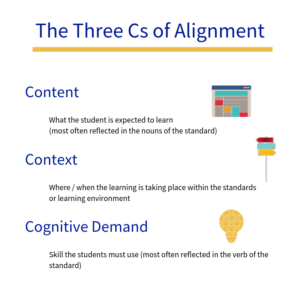During our many conversations regarding the alignment of instructional materials we have found that the concept of curriculum alignment and even the phrase “aligned to standards” means different things to different people. For example, the marketing director of a publishing company recently told us that “aligned to standards” in their marketing material means that their material generally addresses the concepts contained in the standards. In contrast, when we ask educators what they understand when they read that a material is “aligned to standards,” they repeatedly tell us they expect the material to address the content knowledge and skills the standards require students to learn.
Since Learning List is a review service for districts, we review materials from the educators’ perspective. We use the definitions and criterion educators most commonly use when reviewing materials. Thus, when we review materials for alignment to the standards, we check to ensure that the material addresses all of the content and skills the standards require students to learn.

Each standard has three components:
- Content describes what the student is expected to learn. The “content” is typically reflected in the nouns of the standard.
- Context describes where/when the learning is taking place. Examples of the context of a standard include: time periods in history, in informational texts, poems, myths, 2-step word problems, lab experiments, the area of science being studied, and investigative questions.
- Cognitive Demand describes the skills students must use. The cognitive demand is most often reflected in the verb(s) of the standard. Examples of the cognitive demand of a standard include: understand, ask and answer, describe, analyze, compare and contrast, or solve.
Learning List reviews citations (e.g., page or page range, lesson, video, activity) in the publisher’s correlation for alignment to the content, context and cognitive demand of each standard. Each citation is reviewed by multiple subject matter experts (SMEs).* Therefore, our alignment decisions are not just one person’s opinion. We review multiple citations for each standard with the goal of finding three aligned citations so that teachers can use the material to teach and reteach each standard.
Each reviewed citation is listed as “aligned” or “not aligned” in our alignment report, and each non-aligned citation is accompanied by a Reviewer’s Comment explaining precisely which part of the standard the citation failed to address. We do not give publishers credit for aligning to a standard if their material addresses only part of the standard.
However, since standards state what students must have learned by the end of the course, comprehensive materials often scaffold instruction throughout the product. This is particularly true when standards are written as complex sentences, with multiple nouns and verbs. For example, a citation in unit one of the material may address the first part of a standard; a citation in unit five may address the second half of the standard, and a citation in unit seven may address the final part of the standard. Though our SMEs review citations individually for alignment to each standard, if multiple citations each address a different part of the same standard and together completely align to the standard, we provide a Reviewer’s Comment explaining which citations must be “bundled” in order to teach all the knowledge and skills a standard requires. If we find a “bundle” of citations aligns completely to the standard, we give the publisher credit for aligning to that standard.
Once we have completed the alignment review, we calculate the percentage of standards to which the material is aligned. Though our goal is to find multiple aligned citations for each standard, when calculating the alignment percentage, we give the publisher credit for aligning to a standard as long as at least one of the citations reviewed is aligned to that standard.
Why does alignment matter? Because students won’t learn what they are not taught. If teachers are using non-aligned citations to teach a standard, then students may not learn all the knowledge and skills the standard requires them to know. Their learning gaps will impede their ability to answer questions on standards-aligned assessments. We allow educators in subscribing districts to export the aligned citations from our alignment reports into their lessons and intervention plans, so that they know that they are using the parts of their material that will teach students what they need to know.
If you would like to learn more about standards alignment, consider our two-hour, online professional development course, What Alignment Means, Why It Matters, and How to Do It!
*Learning List’s subject matter experts are current or recently retired educators with at least 5 years of teaching experience, who are certified in the grade and subject and have experience teaching the standards of the material they are reviewing.
27 thoughts on “What “Aligned to Standards” Means To K-12 Publishers, Teachers and Students”
Comments are closed.